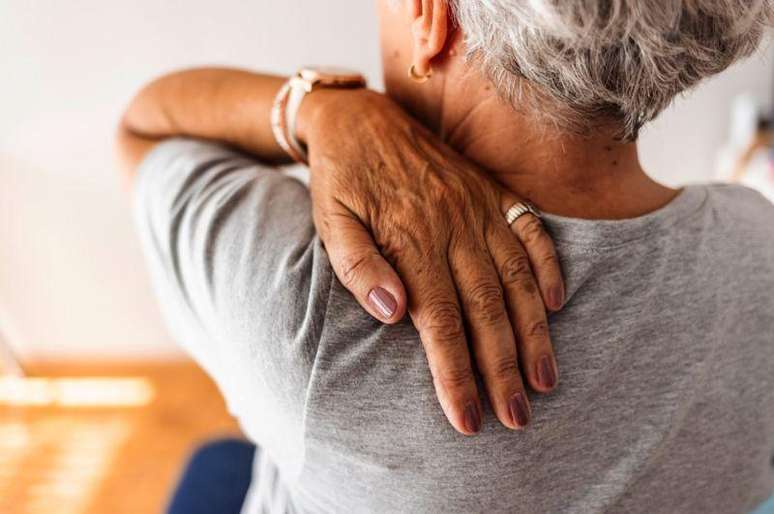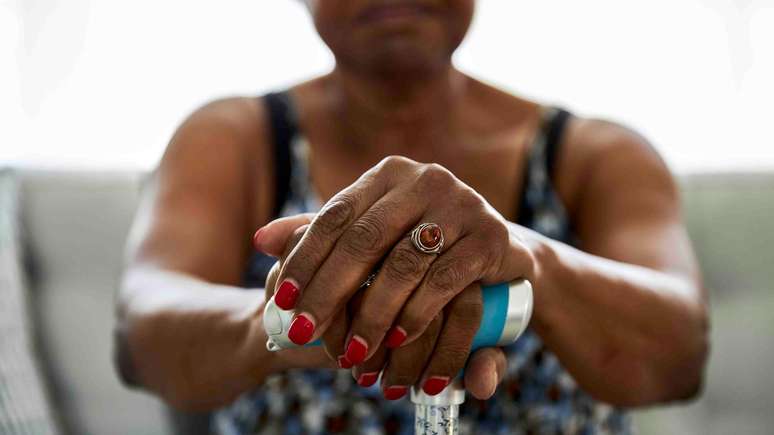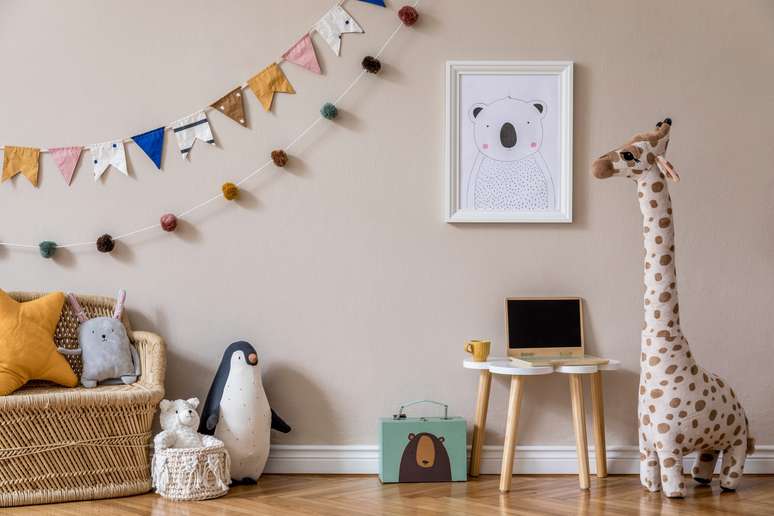Experts explain what is behind the sharp increase recorded by the Ministry of Health and list precautions to reduce risks.
It was a domestic accident that took the life of Georgina Coutinho dos Santos’ husband.
“He went to clean the house, slipped, hit his head on the ground and never returned. On the day of the accident, a Sunday, he was admitted to hospital, but he did not survive,” says Georgina.
What she didn’t imagine was that 22 years later, at the age of 71, she too would be the victim of the same accident.
“It’s a situation we never imagined could happen to us,” he says.
“I recently stepped on a bedspread in my room, slipped, hit my head on the wall, and had a black eye for almost a month. I’m lucky it wasn’t as serious as his situation.”
Just like Georgina, every day in Brazil 63 elderly people seek hospital treatment after falling from heights. Of these, 19 did not survive and died.
Data from the Ministry of Health also reveal that this type of accident has grown rapidly in the country.
In 2013, 4,816 seniors died from falls from heights. In 2022, this number jumped to 9,592 deaths.
Considered the third leading cause of mortality among people over the age of 65, falls killed 70,516 seniors in the country between 2013 and 2022.
Experts interviewed by BBC News Brasil highlight three factors that explain the high incidence of these accidents:
- Less under-reporting of cases of falls from heights by the hospital network, which facilitates the registration of this type of accident and, consequently, increases the number of cases;
- Lack of public policies for the movement of the elderly population, which favors the occurrence of falls.
Why do we fall more as we get older?

Although falls are common throughout life, it is after age 60 that they can become more common.
João Antonio Matheus Guimarães, president of the Brazilian Society of Orthopedics and Traumatology (SBOT), explains that, with natural aging, the human body loses muscle mass and strength, a phenomenon known as sarcopenia.
“This loss of muscle mass causes older adults to have a greater tendency towards imbalance, which ends up causing most accidents,” he points out.
But it’s not just the loss of muscle mass that causes accidents.
“At the same time, people over the age of 60 are more likely to have comorbidities, such as neurological changes, which can, for example, cause dizziness and subsequent falls,” says Guimarães.
This is what happened to Irene Alves dos Santos, 66, who, after fainting at home, suffered a fall that forced her to undergo weeks of physiotherapy.
“I just remember that, as usual, that day, I woke up and went to the garden. That’s when I suddenly fainted,” she says.
“When I woke up, I found myself covered in blood on the floor. To this day, I don’t know how long I stayed there.”
Helped by her son, Irene underwent a series of tests which did not reveal any seriousness of her injuries, but raised the alarm in the family.
“After the scare, we change our routine,” says the pensioner.
“Because I have diabetes and fibromyalgia (chronic disease characterized by severe pain in joints, muscles and tendons), I know I can’t rush out of bed when I wake up like I used to. So today I get up, sit down for a while and then start my day.”
Other comorbidities
Other common comorbidities related to advancing age also figure in the list of reasons that make us fall more as we age.
This is the case of joint diseases, which tend to become more fragile.
Therefore, for example, situations of arthrosis – caused by the progressive wear and tear of the cartilage and inflammation of the joint – are common after the age of 60, potentially causing fatal trips and consequent falls.
“Another cause that generates many accidents due to falls is osteoporosis, a disease characterized by the progressive loss of bone mass, which weakens the bones”, underlines Lourenço Peixoto, orthopedic doctor and director of the Hip Surgery Center of the National Institute of Traumatology and Orthopedics (Into).
“Today we already have numerous drugs that help strengthen bones. Therefore, it is important to always keep an eye on the signals our body sends.”
Problems with near or far vision and a weakened nervous system with a high level of gray hair may also be indicators of the risk of this type of accident occurring.
“Older patients tend to get up more often at night, due to urinary urgency, and are often drowsy,” Guimarães points out.
“When he gets up, he often falls.”
Older, higher risk
Into data shows that the higher the age, the higher the risk of falling. That’s because among seniors age 80 or older, on average, 40% of them experience at least some type of fall each year.
The investigation is in line with the research conducted by nutritionist Ilana Carla Gonçalves of the Federal University of Vales do Jequitinhonha e Mucurí (UFVJM) on the trend of mortality due to falls in the elderly in Brazil.
Analyzing the deaths of elderly Brazilians due to falls between 2000 and 2019, the researcher found that more than half of the deaths involved elderly people aged 80 or older.
In the respective period, of the 135,209 deaths of elderly people due to falls:
- 17.57% were elderly between 60 and 69 years old;
- 26.31% were elderly between 70 and 79 years old;
- 56.12% were seniors aged 80 years or older.
“This number of deaths is already a warning sign, the question that remains is what we are doing to prevent this type of accident”, underlines the researcher.
“This is because when the elderly person does not die, they remain bedridden and have a slower recovery process.”
According to Gonçalves, Brazil must rethink its model of city organization for a population that tends to be increasingly older.
The 2022 demographic census, by the Brazilian Institute of Geography and Statistics (IBGE), showed that 10.9% of the country’s total inhabitants are aged 65 or older – the highest percentage of elderly people compared to the total population since the first census , from 1872. .
“The aging of the population, not accompanied by adequate adaptations of infrastructure and other measures that facilitate mobility and promote the quality of life of this population, may contribute to an increase in the number of deaths following falls from heights”, says Gonçalves.
“Poor public roads, with broken and uneven pavements and insufficient lighting, combined with intrinsic factors resulting from the aging process, create a scenario that leads to more episodes of falls, increasing mortality rates from this cause, which deserves particular attention from managers and healthcare professionals.”
How to avoid falls
However, beyond public policies, experts interviewed by BBC News Brasil underline the need to raise awareness among families of the potential dangers that elderly people face in their homes.
“People need to understand that falling is not normal and that there are attitudes that can prevent these accidents,” says Isabela Oliveira Azevedo Trindade, physiotherapist at the Brazilian Society of Geriatrics and Gerontology (SBGG).
Modifications that can reduce the risk of falls include placing a switch near the bed, having floors with non-slip features, avoiding carpeting and installing grab bars in bathrooms.
At the same time, Trindade advocates changes in the lives of older people, such as giving preference to non-slip shoes and never walking around in socks.
“Along with this, as we age, there is a great need to also invest in physical exercise, because engaging in physical activity reduces the risk of falls,” says the physiotherapist.
For those who have already been the victim of a fall, he emphasizes that it is useless to involve only the family in accident prevention. It is necessary to raise awareness among the elderly themselves.
“As older people, we often have difficulty accepting that we no longer have the agility we once had. I only accepted it after what happened to me, when I turned purple and also broke my arm,” says Georgina, by the way. of the accident he suffered.
“But, thank God, it was just like that, it could have been worse.”
Below is a list of tips to adopt at home to prevent falls:
In the bedroom
- Place a lamp/flashlight and a telephone near the bed;
- Cabinets should have lightweight doors and large handles to make opening easier, as well as interior lighting to help you view your belongings;
- Inside the wardrobe, store clothes in easily accessible places, avoiding high places;
- Replace sheets and comforters with products made from non-slippery materials, such as cotton and wool;
- Don’t leave your bedroom floor messy.
In the living room and corridor
- Arrange the furniture so that there is a clear path to pass;
- Install light switches at the entrance to the premises so that you do not have to walk in the dark;
- Keep telephone, electrical and extension cords out of traffic areas; never under carpets;
- In free areas, place carpets with two adhesive sides or with a non-slip bottom;
- Do not sit on low chairs or sofas, as the level of difficulty required to stand up is greater. Furthermore, these must be comfortable and equipped with armrests;
In the kitchen
- Remove carpets that encourage slipping;
- Immediately clean up any liquid, grease or food spilled on the floor;
- Store food, crockery and other kitchen accessories in easily accessible places;
- Shelves must be securely fixed to the wall and floor to allow for support when necessary;
- Don’t stand on chairs or boxes to reach tall furniture;
On the ladder
- Light switches should be installed at both the bottom and top of the stairs. Another option is to install motion detectors that can automatically provide lighting;
- Have a flashlight stored somewhere nearby in case of a power outage;
- Remove carpets located at the beginning or end of the stairs;
- In the case of fixed carpet, choose one that has a solid color (without drawings or many shapes) so that the edges of the steps can be clearly seen;
- Place non-slip adhesive strips on each edge of the steps;
- Install handrails along the entire length of the stairs, on both sides. They must be at a height of 76 centimeters above the steps.
In the bathroom
- Place a non-slip mat next to the tub or shower for safety when entering and exiting;
- Install grab bars on bathroom walls;
- Mobile showers are more suitable;
- Replace glass shower walls with non-slip material;
- When showering, use a hard plastic chair about 16 inches high if you can’t lower yourself to the floor or feel unsteady.
Source: Ministry of Health
Source: Terra
Ben Stock is a lifestyle journalist and author at Gossipify. He writes about topics such as health, wellness, travel, food and home decor. He provides practical advice and inspiration to improve well-being, keeps readers up to date with latest lifestyle news and trends, known for his engaging writing style, in-depth analysis and unique perspectives.



-1k25lxygpfiat.jpg)





